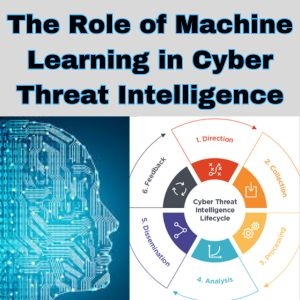The Role of Machine Learning in Cyber Threat IntelligencePosted by Archi Jain on September 25th, 2023  IntroductionWelcome to our blog section on the important topic of Machine Learning and its role in Cyber Threat Intelligence. In today's digital age, data is constantly being generated at an exponential rate, making it a challenge for organizations to keep up with the ever evolving cyber threats. This is where Machine Learning comes in as a key tool that can help organizations stay one step ahead of cyber threats. Firstly, let's define what exactly Machine Learning is. Simply put, it is a subset of Artificial Intelligence (AI) that enables machines to learn and make predictions from data without being explicitly programmed. In other words, it involves giving computers the ability to learn and improve from experience without human intervention. This makes it a powerful tool in the field of Cyber Threat Intelligence, where large amounts of data need to be analyzed quickly and accurately. So how does Machine Learning actually work within Cyber Threat Intelligence? Well, let's take the example of a cybersecurity analyst who needs to analyze large amounts of data in order to detect potential cyber threats. Traditionally, this would involve manually sifting through vast amounts of data and trying to identify patterns or anomalies that could indicate malicious activity. This process can be time consuming and prone to human error. However, with the help of Machine Learning algorithms, this task can be automated – allowing for faster and more accurate detection of cyber threats. In fact, there are many techniques within Machine Learning that can be applied in Cyber Threat Intelligence. For instance, supervised learning involves using labeled datasets (with known outcomes) to train models that can then make predictions on new data. Unsupervised learning involves identifying patterns in unlabeled data without any predefined outcomes – making it useful for anomaly detection and identifying new types of cyber attacks. Understanding Machine Learning and Artificial Intelligence When it comes to cybersecurity, the terms "machine learning" and "artificial intelligence" are often thrown around. But what exactly do these terms mean and how do they play a role in protecting us from cyber threats? In this blog post, we will take a deep dive into understanding machine learning and artificial intelligence in the context of cyber threat intelligence. First, let's define these buzzwords. Machine learning is a subset of artificial intelligence that involves training computer systems to learn from data, identify patterns and make decisions without explicit instructions. On the other hand, artificial intelligence refers to a broader concept of creating intelligent machines that can think and act like humans. Now you may be wondering, how does machine learning fit into the world of data science and cyber threat intelligence? Well, machine learning algorithms can analyze large amounts of data at lightning speed and detect patterns that may not be visible to human analysts. This makes it an invaluable tool for data scientists and cybersecurity professionals in identifying potential threats. One of the biggest advantages of using machine learning in cyber threat intelligence is its ability to continuously learn and adapt based on new data. As cyber threats are constantly evolving, traditional rule based systems may become outdated quickly. However, with machine learning algorithms continuously improving themselves through new data inputs, they can stay ahead of emerging threats. There are several ways in which machine learning can be applied to strengthen cybersecurity measures. One example is using anomaly detection algorithms to identify unusual behavior such as an influx of network requests or abnormal user activity on a system. Another example is using natural language processing algorithms to analyze text based communications for any suspicious keywords or phrases. The Importance of Data Science in Cyber Threat IntelligenceMachine learning, a subset of artificial intelligence (AI), is revolutionizing the field of cybersecurity by allowing for the identification and classification of cyber threats in real time. It utilizes powerful algorithms to analyze large amounts of data and detect patterns that may indicate a potential threat. By constantly learning from new data, machine learning algorithms are able to evolve and adapt to new methods used by hackers. But why is data science and machine learning so important in the context of cyber threats? For starters, traditional methods of threat detection such as manual analysis or rule based systems are no longer effective against sophisticated attacks. Cybercriminals are constantly finding new ways to infiltrate systems, making it difficult for humans alone to keep up with them. This is where machine learning comes in – it can analyze vast amounts of data within seconds, something that would take humans hours or even days. Moreover, machine learning allows for real time threat detection, meaning that potential threats can be identified and addressed before they cause any harm. This not only saves time but also prevents potential losses for businesses who may be targeted by cybercriminals. How Machine Learning is Used to Detect Malicious ActivitiesIn this era of technology, machine learning has become an integral part of our lives. It is constantly evolving and has greatly impacted various industries such as healthcare, finance, and marketing. But one industry where its use is becoming more prevalent and crucial is cybersecurity. With the increasing number of cyber threats and attacks, organizations are turning to machine learning for detecting malicious activities and staying ahead of potential cyber attacks. So, how exactly does machine learning play a role in detecting these malicious activities? Well, let’s dive in. Firstly, let’s understand what machine learning is. In simple terms, it is an application of artificial intelligence (AI) that allows systems to learn and improve from experience without being explicitly programmed. This means that instead of traditional programming rules, the system can learn from data and make decisions based on patterns and trends. Now you might wonder how this applies to cybersecurity? Well, machine learning algorithms can be trained using vast amounts of data from previous cyber attacks or known patterns associated with cyber threats. This helps in identifying anomalies or suspicious activities in realtime that may indicate a potential cyber threat. In fact, data science plays an essential role in analyzing large datasets quickly and efficiently to identify these patterns. One important aspect to note is that cyber threats are constantly evolving in terms of their sophistication and complexity. Therefore, relying solely on traditional methods for threat detection may not be enough. This is where machine learning comes into play as it can continuously analyze data and adapt to new patterns without human intervention. Let’s take the example of anomaly detection, a popular use case for machine learning in cybersecurity. Anomaly detection involves identifying abnormal user behavior or network traffic that could potentially lead to an attack. Enhancing Security with Machine Learning Algorithms ML and AI are rapidly gaining importance in enhancing security measures against cyber threats. These technologies have revolutionized the way we handle data, making it easier for us to detect potential threats and take preventive measures before they can cause any harm. One of the main reasons why ML and AI are crucial in cybersecurity is because of their ability to process large amounts of data at a rapid pace. The use of Data Science techniques in combination with machine learning algorithms allows for more accurate and efficient detection of potential cyber threats. These algorithms can quickly analyze complex patterns and identify anomalies that indicate a possible attack. Automated threat intelligence using machine learning is becoming increasingly popular among organizations as it helps them stay ahead of constantly evolving cyber attacks. With traditional methods, it was difficult to keep up with the ever changing tactics used by hackers. However, with M powered automated threat intelligence, organizations can continuously monitor their networks and systems for suspicious activities. Challenges and Limitations of Implementing Machine Learning in Cyber Threat IntelligenceWith the rapid growth of technology and the amount of data being produced, traditional methods of threat intelligence are no longer enough to keep up with the constantly evolving nature of cyber attacks. This is where machine learning and AI come into play. These advanced technologies have the potential to revolutionize the way we identify and respond to cyber threats, making our systems and networks more secure.
Machine learning, a subset of artificial intelligence, is a powerful tool that enables computers to learn from data without being explicitly programmed. By analyzing large amounts of data, machine learning algorithms can identify patterns and make predictions, thus helping cybersecurity professionals detect potential threats before they even occur. Similarly, AI also plays a crucial role in cyber threat intelligence by automating processes such as threat detection and response. This saves time for cybersecurity teams, who can then focus on developing strategies to mitigate these threats and prevent future attacks.
Traditional threat intelligence methods typically involve gathering information from various sources such as blacklists, indicators of compromise (IoC), security logs, etc., manually correlating this data to identify patterns or anomalies that may indicate a potential attack. However, with the sheer volume of data being generated every day, this manual approach becomes increasingly difficult. Moreover, traditional methods primarily rely on rule based systems that cannot adapt or evolve based on new information or changing attack patterns. This makes it challenging to keep up with the ever changing tactics used by cybercriminals to breach systems and networks. You can also read:UNext data science course review Like it? Share it!More by this author |


